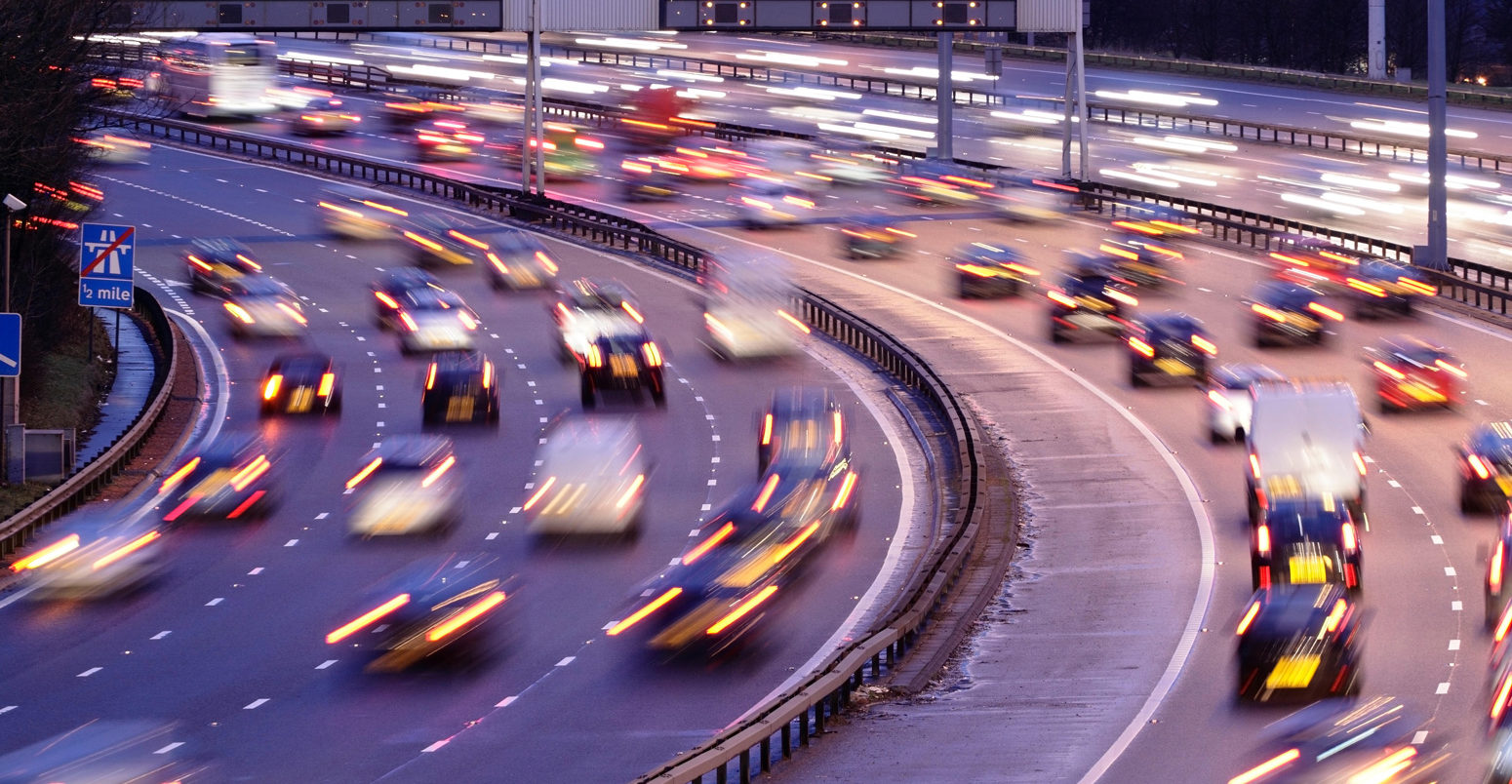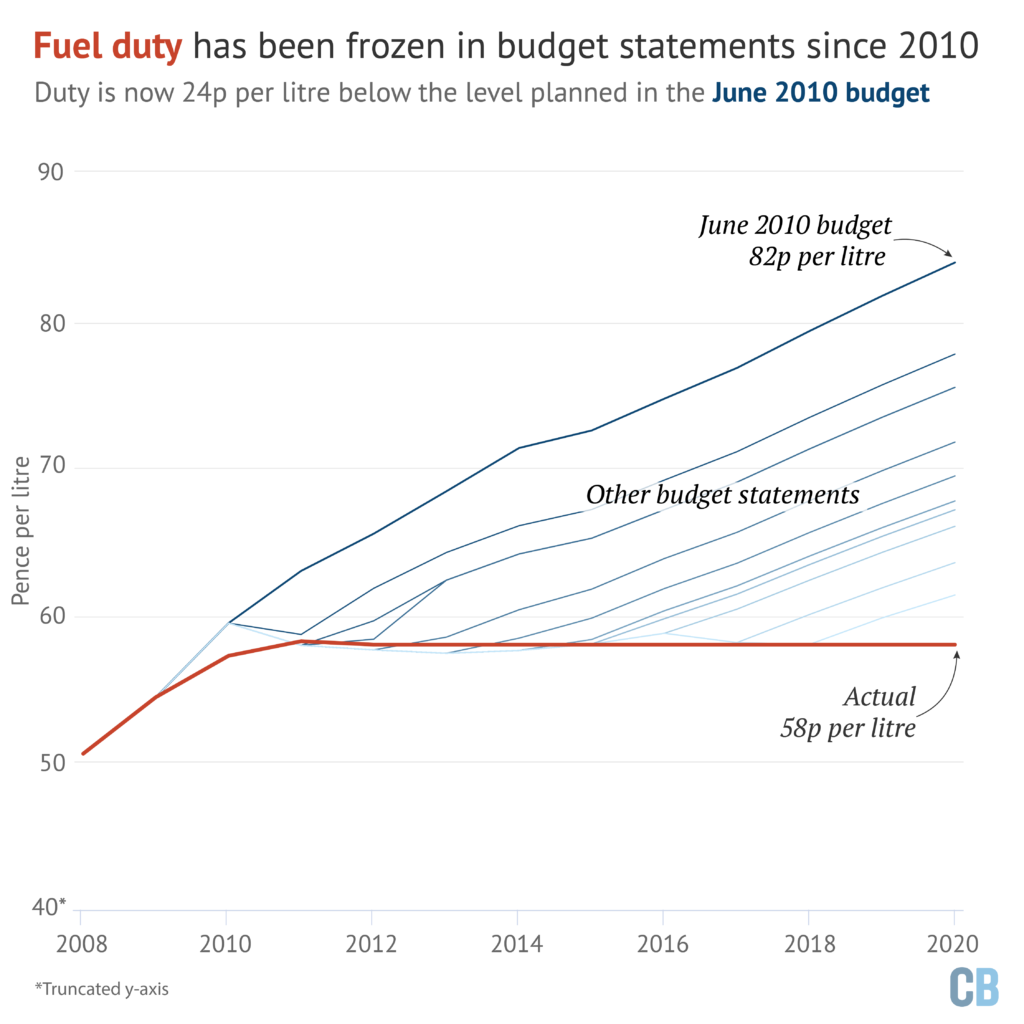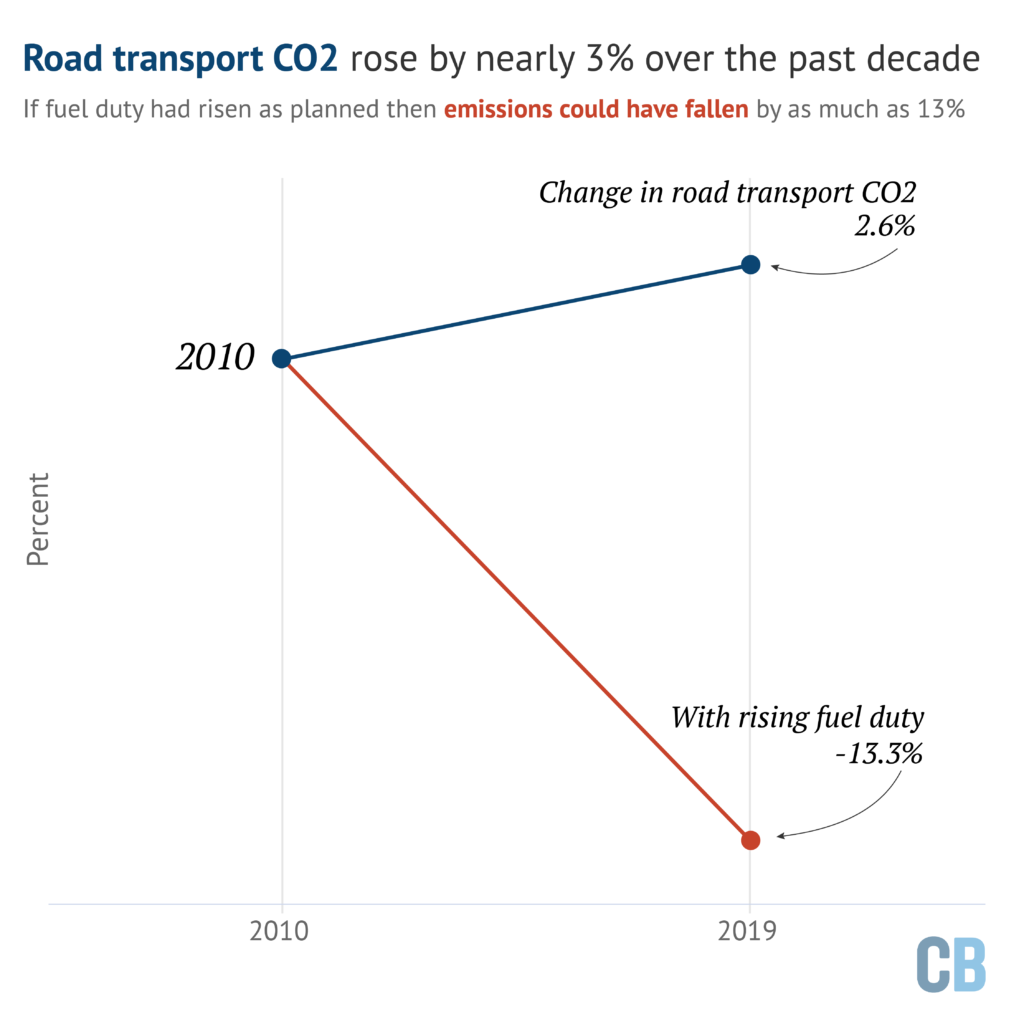
Analysis: Fuel-duty freeze has increased UK CO2 emissions by up to 5%
Simon Evans
03.10.20Simon Evans
10.03.2020 | 8:00amThe freeze in fuel duty since 2010 means the UK’s CO2 emissions are as much as 5% higher than they would have been, Carbon Brief analysis shows.
The analysis comes amid widespread lobbying and speculation over the future of fuel duty in the UK’s next budget, due to be announced by the new chancellor Rishi Sunak on 11 March.
Fuel duty is currently applied to petrol and diesel sales in the UK at a rate of 58 pence per litre, plus VAT. Instead of rising with inflation, this rate has been frozen since 2010, meaning motorists have enjoyed a large price cut in real terms, even as public transport fares have risen faster than inflation.
If fuel duty had increased each year as planned in the June budget 2010, then pump prices would have been a fifth higher than they are today. Higher prices would have cut CO2 in 2019 by 2-18 million tonnes of CO2 (MtCO2), some 0.5-5.0% of overall UK carbon emissions, Carbon Brief analysis shows.
Instead, transport is now the largest contributor to the UK’s carbon emissions, having overtaken the power sector in 2015. Road transport emissions rose by around 3% over the past decade and cars alone are now responsible for a larger share of the total than all of the country’s power stations put together.
Fuel-duty freezes
According to the Institute of Fiscal Studies (IFS), the respected economic thinktank, forecasts of UK government finances assume that fuel duty will increase in line with inflation at the start of each financial year.
But successive governments have frozen the rate of fuel duty each year since 2010, meaning motorists have enjoyed a significant tax cut in real terms.
The chart below shows how the rate of fuel duty, in pence per litre of petrol or diesel, has been frozen at the same level since 2010 (thick red line, nominal prices). Planned increases are shown in shades of blue, corresponding to budgetary forecasts in 2010 onwards.

According to the IFS, the ongoing fuel-duty freeze is costing the exchequer some £11.2bn in the current financial year 2019-20 alone, rising to £13.9bn in 2022-23 if the freeze continues.
(These figures are relative to the planned fuel duty “escalator”, as of June 2010, inherited from the outgoing Labour government. This would have seen the level of fuel duty go up by 1p above inflation each year. Update 12/04/2023: The escalator was first introduced by the Conservatives under John Major, in 1993.)
As of March 2020, the fuel-duty freeze means that pump prices for petrol and diesel are some 28p per litre lower (23%) than they would have been, if the June 2010 plans had gone ahead.
In an October 2019 report on the taxation of motoring, the IFS notes that UK rates of fuel duty are “high by international standards” and that low-income car-owning households are particularly vulnerable to even higher rates. (It adds that, since low-income households are much less likely to own a car, fuel duties are not regressive overall.)
The thinktank also says: “Fuel duty rates are set higher than can be justified by emissions alone, but are much too low – and too poorly targeted – to reflect the costs of congestion.
It adds that the £28bn due to be collected via fuel duties in 2019-20 will “all but disappear” as drivers shift to zero-carbon transport, if the UK’s target to reach net-zero emissions by 2050 is to be met.
Nevertheless, the IFS concludes by arguing that fuel duties should once again start rising in line with inflation. It says: “There is no case for the recurrent ritual…when planned inflation uprating of fuel duties has been repeatedly cancelled for one more year.
This week’s budget comes amid tumbling oil prices, after the breakdown of a deal between Russia and OPEC, the oil producers’ cartel, as well as the hit to demand from the coronavirus outbreak.
In 2012, then-chancellor George Osborne introduced a “fair fuel stabiliser”, later ignored, designed to raise fuel duties when oil prices were low and postpone increases if oil prices were high.
Emissions effect
Regardless of the merits of current fuel duty rates, there is strong economic evidence that higher pump prices would have reduced demand and, consequently, CO2 emissions.
The key determinant of this effect is the “elasticity of demand”, which measures how sensitive consumers are to changes in price. If elasticity is high, then a rise in prices will have a relatively larger impact on demand. If elasticity is low, then demand may not change much.
The elasticity of demand is usually understood to increase over time, as consumers are able to adjust by changing their habits or buy more efficient cars. See below for further discussion.
Any change in the amount of CO2 released by burning petrol and diesel could have had a significant impact on the national total. This is because the transport sector is now the single-largest contributor to UK greenhouse gas emissions, accounting for a quarter of the total.
While the UK overall has cut its CO2 output by 29% over the past decade, emissions from road transport have increased by 3%. And emissions from cars alone, at around 70MtCO2 in 2019, are now far ahead of the nation’s power stations, which collectively emitted less than 60MtCO2.
Against this backdrop, Carbon Brief’s new analysis shows that road-transport emissions would have been some 2-18MtCO2 lower in 2019, if fuel duty increases had gone ahead as planned. (The range reflects different estimates of the elasticity of demand, explored in more detail below.)
Instead of road-transport emissions rising by 3% between 2010 and 2019, planned fuel-duty increases could, therefore, have cut CO2 output by as much as 13%, as the chart below shows.

These figures show that planned fuel-duty increases could have cut overall UK CO2 emissions by between 0.5 and 5.0% in 2019, depending on the elasticity of demand.
The figures above exclude CO2 emissions from refineries, which stood at 13MtCO2 in 2018. If fuel-duty increases had cut refinery output in line with falling demand for petrol and diesel, then the overall impact on UK emissions could have reached 2-20MtCO2 in 2019.
Note that Carbon Brief’s analysis does not distinguish between petrol and diesel sales subject to the standard rate of fuel duty, versus tax exempt sales of “red diesel”, which account for 15% of all diesel use. Permitted uses of red diesel include farm vehicles, heating oil, generators and railways.
Elasticity of demand
The main uncertainty in Carbon Brief’s analysis, as mentioned above, is the elasticity of demand. A 2014 report from the Treasury and HMRC looked at a range of estimates for the impact of fuel-duty changes on demand, including those from within government and shown in the table, below.
For comparison, an elasticity of -1 means that a 10% increase in prices would translate into a 10% reduction in demand. The figures in the table below are lower than this, often substantially so.
| Source | Description | Price Elasticity |
|---|---|---|
| HMRC indirect taxes forecasting model | These elasticities underlie the ORB's forecast of fuel duty receipts. | -0.07 in the short term -0.13 in the medium-term |
| Dahl (2019) | A meta study examining the elasticities for petrol and diesel for various countries | -0.11 to -0.33 for petrol -0.13 to -0.38 for diesel |
| Brons et al | A meta study exploring both short-run and long-run elasticities. | -0.34 in the short-term -0.84 in the long-term |
| Parry and Small | A study exploring the ideal fuel tax for the UK and the US. | -0.55 with a range of -0.3 to -0.9 |
Researchers agree that the short-term elasticity of fuel demand is relatively low, perhaps around -0.1, says Hector Pollitt, head of modelling at consultancy Cambridge Econometrics. This is because consumers may have few immediate ways to cut car use for their commute, for example.
But higher prices can have much larger impacts on demand if sustained over longer periods, Pollitt tells Carbon Brief. This is because there is time for society to adapt, he explains: consumers may decide to change travel habits by using alternative modes of transport, or their next car may be more fuel efficient. In turn, car manufacturers may be encouraged to develop cleaner models.
In its own modelling work, Cambridge Econometrics has used a figure of -0.7 as the long-run elasticity of fuel demand, Pollitt says. He adds that there is the potential for even larger, non-linear effects now that hybrid and electric vehicles are widely available.
(If a consumer replaces a combustion car with an electric vehicle, at least in part because fuel is expensive, then their personal demand for petrol or diesel will fall to zero.)
For the analysis of fuel-duty impacts on road-transport emissions, Carbon Brief has provided a range of estimates based on the short-term elasticity estimate from HMRC at the low end and on Cambridge Econometrics’ long-run figure at the high end.
Pollitt also points to research, published in 2018 by Prof Michael Grubb and colleagues, which finds that long-run energy expenditure is constant, relative to GDP. This report says:
“A constant level of energy expenditure, ceteris paribus [if other things are equal], would imply an elasticity of (minus)1 – considerably higher than classical time-series measures of energy demand-price elasticity (which point to long-run elasticities of (minus) 0.6-0.7 at most)…[T]he data clearly imply that energy systems have a large capacity to adapt to higher prices and other pressures, given time.”
Noting the potentially regressive nature of higher fuel duties, the Grubb research report adds:
“[S]imply imposing higher prices can carry a significant welfare cost, particularly on poorer households…To combine regulatory certainty with flexibility, it is also possible that price-based instruments (such as fuel duties or environmental pricing) could be designed with escalators that are automatically paused if expenditure thresholds are exceeded and resume when expenditure falls.”
Methodology
Carbon Brief’s estimate of the CO2 impact of fuel-duty freezes is based on increases recorded by the IFS as having been planned in June 2010. If these increases had gone ahead, then pump prices would have been some 23% higher than they were, as of the most recently weekly data, or 22% based on the 2019 average figures.
These figures are converted into changes in demand and CO2 emissions using a range of estimates for the elasticity of demand, discussed above. For example, if the price elasticity is -0.7 then a 22% increase in price would have caused a 15% decrease in demand. The demand reduction is assumed to correspond directly to a reduction in emissions.
Road transport and refinery emissions are based on the 2018 final greenhouse gas emissions figures published by the Department for Business, Energy and Industrial Strategy. Figures for 2019 are estimated using the latest quarterly traffic statistics, published by the Department for Transport.
The UK’s CO2 emissions in 2019 are taken from Carbon Brief estimates published last week.

